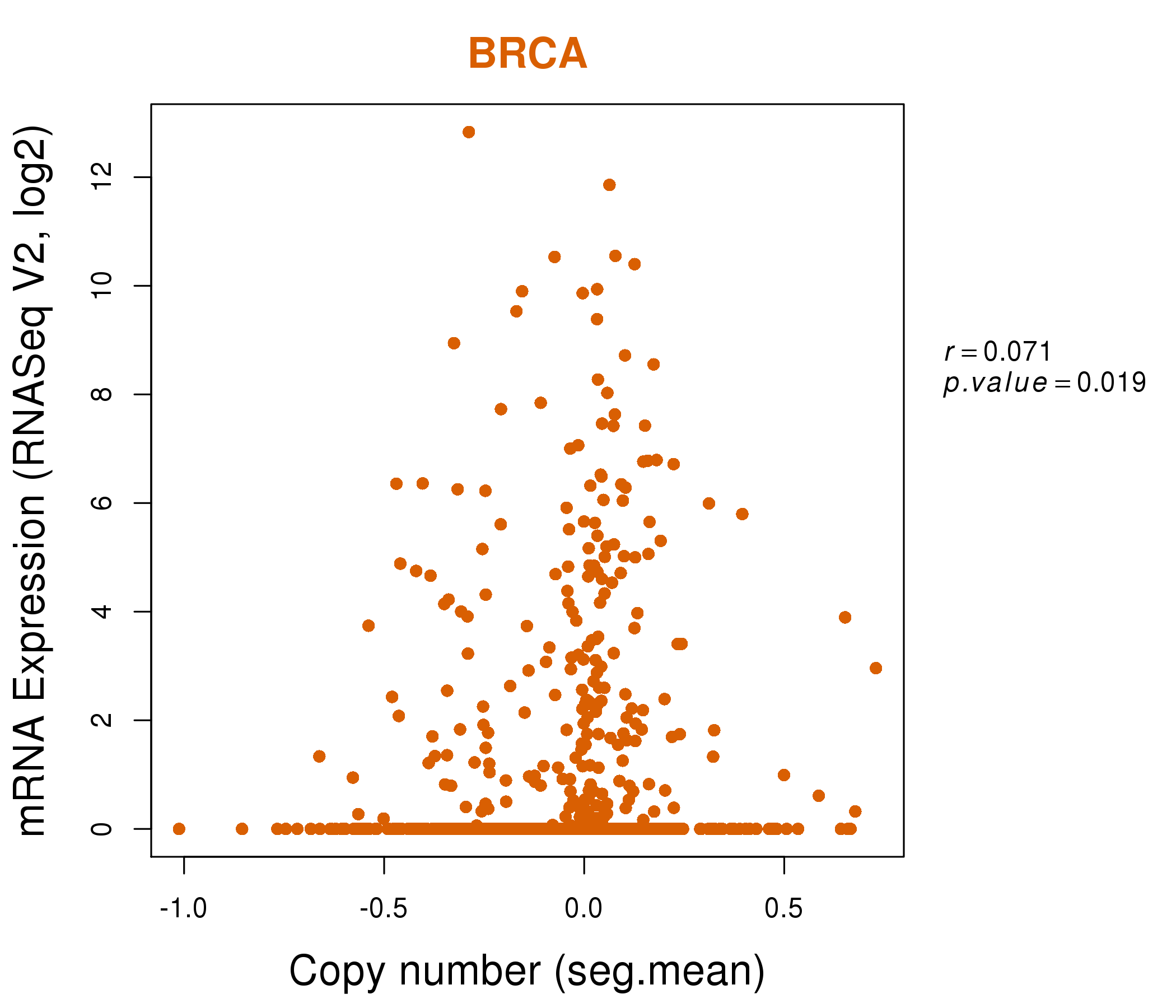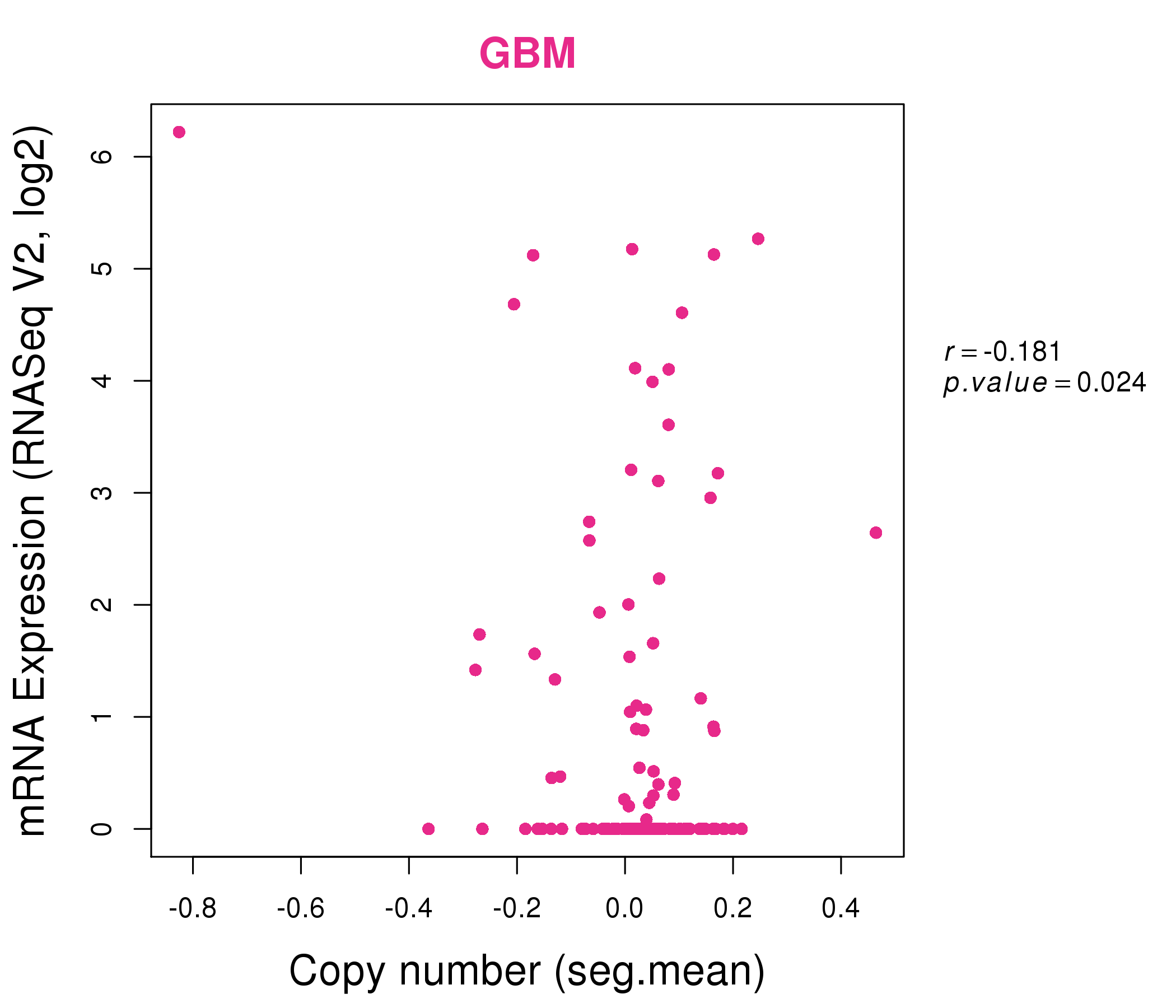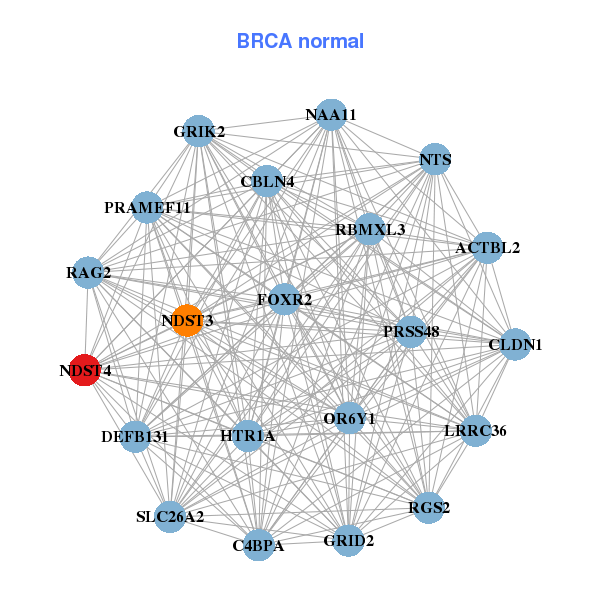|
||||||||||||||||||||||||||||||||||||||||||||||||||||||||||||||||||||||||||||||||||||||||||||||||||||||||||||||||||||||||||||||||||||||||||||||||||||||||||||||||||||||||||||||||||||||||||||||||||||||||||||||||||||||||||||||||||||||||||||||||||||||||||||||||||||||||||||||||||||||||||||||||||||||||||||||||||||||||||
| |
| Phenotypic Information (metabolism pathway, cancer, disease, phenome) |
| |
| |
| Gene-Gene Network Information: Co-Expression Network, Interacting Genes & KEGG |
| |
|
| Gene Summary for NDST4 |
| Basic gene info. | Gene symbol | NDST4 |
| Gene name | N-deacetylase/N-sulfotransferase (heparan glucosaminyl) 4 | |
| Synonyms | NDST-4|NHSST4 | |
| Cytomap | UCSC genome browser: 4q26 | |
| Genomic location | chr4 :115748926-116035032 | |
| Type of gene | protein-coding | |
| RefGenes | NM_022569.1, | |
| Ensembl id | ENSG00000138653 | |
| Description | N-HSST 4N-heparan sulfate sulfotransferase 4bifunctional heparan sulfate N-deacetylase/N-sulfotransferase 4glucosaminyl N-deacetylase/N-sulfotransferase 4 | |
| Modification date | 20141207 | |
| dbXrefs | MIM : 615039 | |
| HGNC : HGNC | ||
| Ensembl : ENSG00000138653 | ||
| HPRD : 10116 | ||
| Vega : OTTHUMG00000132916 | ||
| Protein | UniProt: go to UniProt's Cross Reference DB Table | |
| Expression | CleanEX: HS_NDST4 | |
| BioGPS: 64579 | ||
| Gene Expression Atlas: ENSG00000138653 | ||
| The Human Protein Atlas: ENSG00000138653 | ||
| Pathway | NCI Pathway Interaction Database: NDST4 | |
| KEGG: NDST4 | ||
| REACTOME: NDST4 | ||
| ConsensusPathDB | ||
| Pathway Commons: NDST4 | ||
| Metabolism | MetaCyc: NDST4 | |
| HUMANCyc: NDST4 | ||
| Regulation | Ensembl's Regulation: ENSG00000138653 | |
| miRBase: chr4 :115,748,926-116,035,032 | ||
| TargetScan: NM_022569 | ||
| cisRED: ENSG00000138653 | ||
| Context | iHOP: NDST4 | |
| cancer metabolism search in PubMed: NDST4 | ||
| UCL Cancer Institute: NDST4 | ||
| Assigned class in ccmGDB | C | |
| Top |
| Phenotypic Information for NDST4(metabolism pathway, cancer, disease, phenome) |
| Cancer | CGAP: NDST4 |
| Familial Cancer Database: NDST4 | |
| * This gene is included in those cancer gene databases. |
|
|
|
|
|
|
| ||||||||||||||||||||||||||||||||||||||||||||||||||||||||||||||||||||||||||||||||||||||||||||||||||||||||||||||||||||||||||||||||||||||||||||||||||||||||||||||||||||||||||||||||||||||||||||||||||||||||||||||||||||||||||||||||||||||||||||||||||||||||||||||||||||||||||||||||||||||||||||||||||||||||||||||||||||
Oncogene 1 | Significant driver gene in | |||||||||||||||||||||||||||||||||||||||||||||||||||||||||||||||||||||||||||||||||||||||||||||||||||||||||||||||||||||||||||||||||||||||||||||||||||||||||||||||||||||||||||||||||||||||||||||||||||||||||||||||||||||||||||||||||||||||||||||||||||||||||||||||||||||||||||||||||||||||||||||||||||||||||||||||||||||||||
| cf) number; DB name 1 Oncogene; http://nar.oxfordjournals.org/content/35/suppl_1/D721.long, 2 Tumor Suppressor gene; https://bioinfo.uth.edu/TSGene/, 3 Cancer Gene Census; http://www.nature.com/nrc/journal/v4/n3/abs/nrc1299.html, 4 CancerGenes; http://nar.oxfordjournals.org/content/35/suppl_1/D721.long, 5 Network of Cancer Gene; http://ncg.kcl.ac.uk/index.php, 1Therapeutic Vulnerabilities in Cancer; http://cbio.mskcc.org/cancergenomics/statius/ |
| REACTOME_METABOLISM_OF_CARBOHYDRATES | |
| OMIM | |
| Orphanet | |
| Disease | KEGG Disease: NDST4 |
| MedGen: NDST4 (Human Medical Genetics with Condition) | |
| ClinVar: NDST4 | |
| Phenotype | MGI: NDST4 (International Mouse Phenotyping Consortium) |
| PhenomicDB: NDST4 | |
| Mutations for NDST4 |
| * Under tables are showing count per each tissue to give us broad intuition about tissue specific mutation patterns.You can go to the detailed page for each mutation database's web site. |
| - Statistics for Tissue and Mutation type | Top |
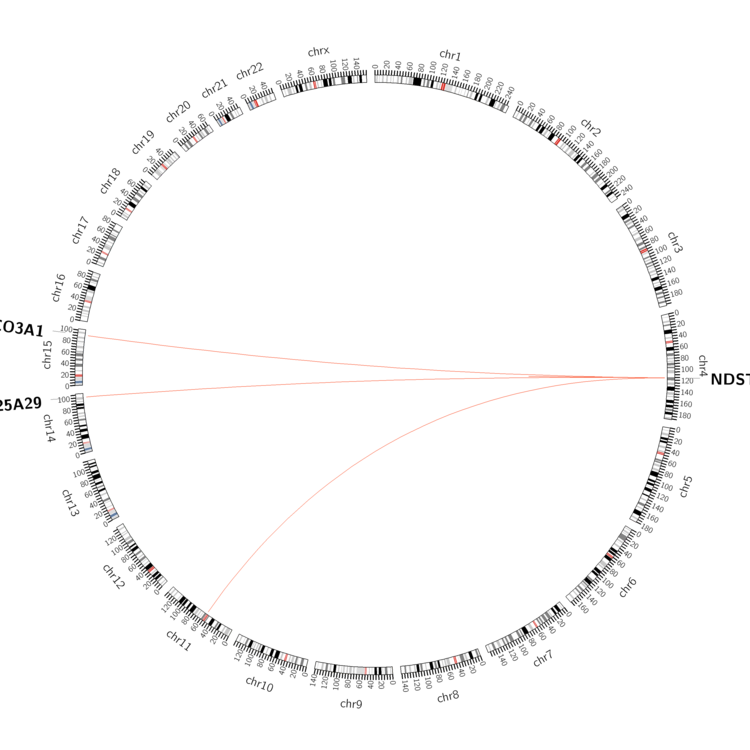 |
| - For Inter-chromosomal Variations |
| * Inter-chromosomal variantions includes 'interchromosomal amplicon to amplicon', 'interchromosomal amplicon to non-amplified dna', 'interchromosomal insertion', 'Interchromosomal unknown type'. |
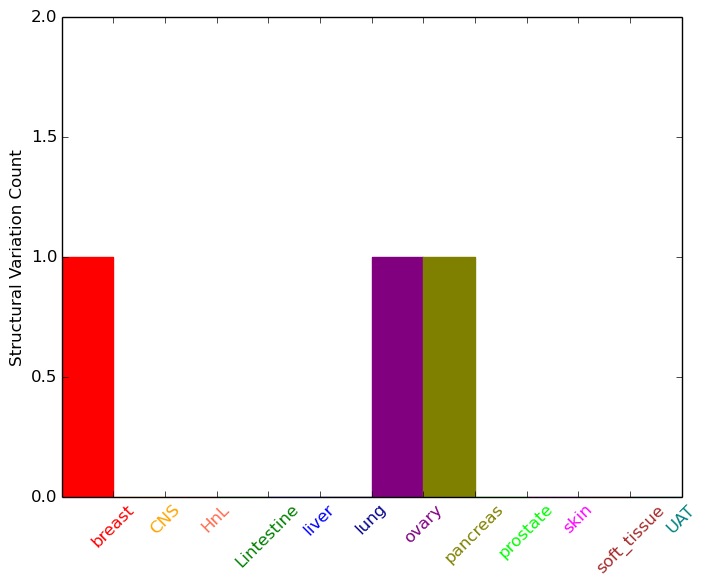 |
| - For Intra-chromosomal Variations |
| * Intra-chromosomal variantions includes 'intrachromosomal amplicon to amplicon', 'intrachromosomal amplicon to non-amplified dna', 'intrachromosomal deletion', 'intrachromosomal fold-back inversion', 'intrachromosomal inversion', 'intrachromosomal tandem duplication', 'Intrachromosomal unknown type', 'intrachromosomal with inverted orientation', 'intrachromosomal with non-inverted orientation'. |
 |
| Sample | Symbol_a | Chr_a | Start_a | End_a | Symbol_b | Chr_b | Start_b | End_b |
| breast | NDST4 | chr4 | 115981060 | 115981460 | SLC25A29 | chr14 | 100771204 | 100771604 |
| pancreas | NDST4 | chr4 | 115801627 | 115801827 | NDST4 | chr4 | 115795448 | 115795648 |
| pancreas | NDST4 | chr4 | 116003076 | 116003096 | chr11 | 55441084 | 55441104 |
| cf) Tissue number; Tissue name (1;Breast, 2;Central_nervous_system, 3;Haematopoietic_and_lymphoid_tissue, 4;Large_intestine, 5;Liver, 6;Lung, 7;Ovary, 8;Pancreas, 9;Prostate, 10;Skin, 11;Soft_tissue, 12;Upper_aerodigestive_tract) |
| * From mRNA Sanger sequences, Chitars2.0 arranged chimeric transcripts. This table shows NDST4 related fusion information. |
| ID | Head Gene | Tail Gene | Accession | Gene_a | qStart_a | qEnd_a | Chromosome_a | tStart_a | tEnd_a | Gene_a | qStart_a | qEnd_a | Chromosome_a | tStart_a | tEnd_a |
| U47050 | NDST4 | 1 | 160 | 4 | 116034598 | 116034757 | TRPC3 | 156 | 3416 | 4 | 122800183 | 122854200 | |
| Top |
| Mutation type/ Tissue ID | brca | cns | cerv | endome | haematopo | kidn | Lintest | liver | lung | ns | ovary | pancre | prost | skin | stoma | thyro | urina | |||
| Total # sample | 2 | 1 | 1 | 2 | 1 | |||||||||||||||
| GAIN (# sample) | 1 | 1 | ||||||||||||||||||
| LOSS (# sample) | 1 | 1 | 1 | 1 | 1 |
| cf) Tissue ID; Tissue type (1; Breast, 2; Central_nervous_system, 3; Cervix, 4; Endometrium, 5; Haematopoietic_and_lymphoid_tissue, 6; Kidney, 7; Large_intestine, 8; Liver, 9; Lung, 10; NS, 11; Ovary, 12; Pancreas, 13; Prostate, 14; Skin, 15; Stomach, 16; Thyroid, 17; Urinary_tract) |
| Top |
|
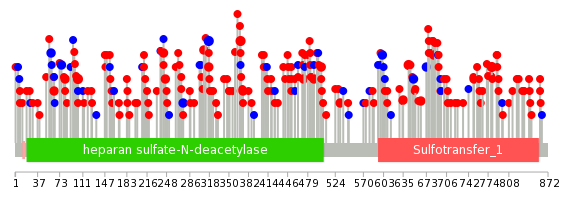 |
| Top |
| Stat. for Non-Synonymous SNVs (# total SNVs=139) | (# total SNVs=39) |
 | 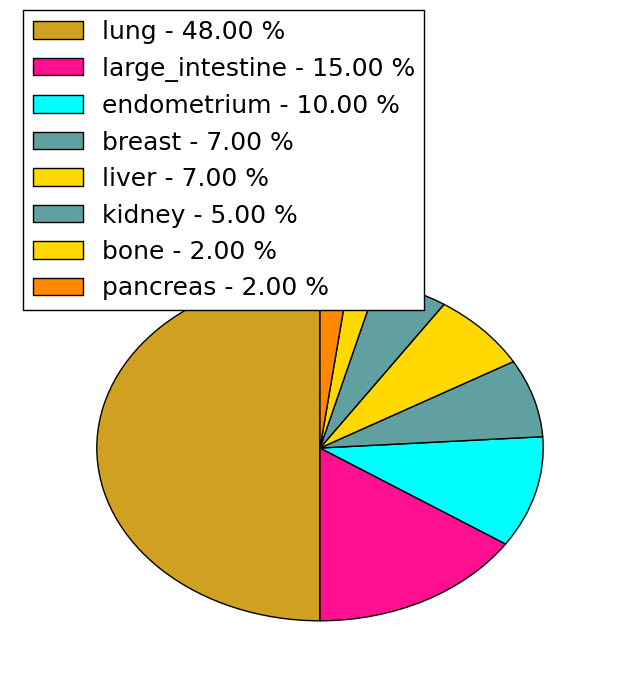 |
(# total SNVs=1) | (# total SNVs=1) |
 | 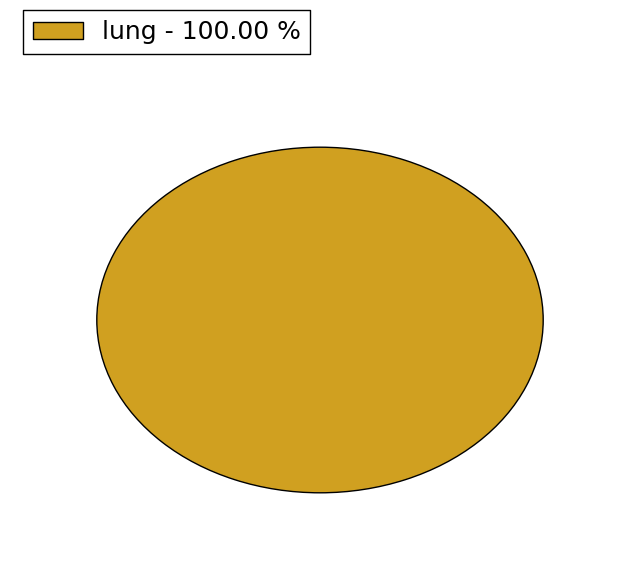 |
| Top |
| * When you move the cursor on each content, you can see more deailed mutation information on the Tooltip. Those are primary_site,primary_histology,mutation(aa),pubmedID. |
| GRCh37 position | Mutation(aa) | Unique sampleID count |
| chr4:115998159-115998159 | p.R12* | 6 |
| chr4:115997885-115997885 | p.R103Q | 4 |
| chr4:115891702-115891702 | p.R369W | 3 |
| chr4:115769380-115769380 | p.G644E | 3 |
| chr4:115891689-115891689 | p.E373V | 3 |
| chr4:115998003-115998003 | p.E64* | 3 |
| chr4:115997242-115997242 | p.G317G | 3 |
| chr4:115754820-115754820 | p.D780N | 3 |
| chr4:115997368-115997368 | p.L275L | 3 |
| chr4:115997949-115997949 | p.L82F | 2 |
| Top |
|
 |
| Point Mutation/ Tissue ID | 1 | 2 | 3 | 4 | 5 | 6 | 7 | 8 | 9 | 10 | 11 | 12 | 13 | 14 | 15 | 16 | 17 | 18 | 19 | 20 |
| # sample | 3 | 2 | 1 | 15 | 5 | 10 | 5 | 1 | 33 | 13 | 2 | 4 | 39 | 14 | 1 | 11 | ||||
| # mutation | 3 | 2 | 1 | 15 | 5 | 10 | 5 | 1 | 38 | 15 | 2 | 4 | 51 | 14 | 1 | 15 | ||||
| nonsynonymous SNV | 2 | 1 | 12 | 5 | 7 | 5 | 26 | 11 | 2 | 4 | 40 | 12 | 1 | 11 | ||||||
| synonymous SNV | 1 | 2 | 3 | 3 | 1 | 12 | 4 | 11 | 2 | 4 |
| cf) Tissue ID; Tissue type (1; BLCA[Bladder Urothelial Carcinoma], 2; BRCA[Breast invasive carcinoma], 3; CESC[Cervical squamous cell carcinoma and endocervical adenocarcinoma], 4; COAD[Colon adenocarcinoma], 5; GBM[Glioblastoma multiforme], 6; Glioma Low Grade, 7; HNSC[Head and Neck squamous cell carcinoma], 8; KICH[Kidney Chromophobe], 9; KIRC[Kidney renal clear cell carcinoma], 10; KIRP[Kidney renal papillary cell carcinoma], 11; LAML[Acute Myeloid Leukemia], 12; LUAD[Lung adenocarcinoma], 13; LUSC[Lung squamous cell carcinoma], 14; OV[Ovarian serous cystadenocarcinoma ], 15; PAAD[Pancreatic adenocarcinoma], 16; PRAD[Prostate adenocarcinoma], 17; SKCM[Skin Cutaneous Melanoma], 18:STAD[Stomach adenocarcinoma], 19:THCA[Thyroid carcinoma], 20:UCEC[Uterine Corpus Endometrial Carcinoma]) |
| Top |
| * We represented just top 10 SNVs. When you move the cursor on each content, you can see more deailed mutation information on the Tooltip. Those are primary_site, primary_histology, mutation(aa), pubmedID. |
| Genomic Position | Mutation(aa) | Unique sampleID count |
| chr4:115769380 | p.G317G | 3 |
| chr4:115997242 | p.F652F | 3 |
| chr4:115767138 | p.G644E | 3 |
| chr4:115997368 | p.L275F | 3 |
| chr4:115858527 | p.P452A | 2 |
| chr4:115760697 | p.E373V | 2 |
| chr4:115767075 | p.R708L | 2 |
| chr4:115997244 | p.G317R | 2 |
| chr4:115891689 | p.D286N | 2 |
| chr4:115997337 | p.S673S | 2 |
| * Copy number data were extracted from TCGA using R package TCGA-Assembler. The URLs of all public data files on TCGA DCC data server were gathered on Jan-05-2015. Function ProcessCNAData in TCGA-Assembler package was used to obtain gene-level copy number value which is calculated as the average copy number of the genomic region of a gene. |
 |
| cf) Tissue ID[Tissue type]: BLCA[Bladder Urothelial Carcinoma], BRCA[Breast invasive carcinoma], CESC[Cervical squamous cell carcinoma and endocervical adenocarcinoma], COAD[Colon adenocarcinoma], GBM[Glioblastoma multiforme], Glioma Low Grade, HNSC[Head and Neck squamous cell carcinoma], KICH[Kidney Chromophobe], KIRC[Kidney renal clear cell carcinoma], KIRP[Kidney renal papillary cell carcinoma], LAML[Acute Myeloid Leukemia], LUAD[Lung adenocarcinoma], LUSC[Lung squamous cell carcinoma], OV[Ovarian serous cystadenocarcinoma ], PAAD[Pancreatic adenocarcinoma], PRAD[Prostate adenocarcinoma], SKCM[Skin Cutaneous Melanoma], STAD[Stomach adenocarcinoma], THCA[Thyroid carcinoma], UCEC[Uterine Corpus Endometrial Carcinoma] |
| Top |
| Gene Expression for NDST4 |
| * CCLE gene expression data were extracted from CCLE_Expression_Entrez_2012-10-18.res: Gene-centric RMA-normalized mRNA expression data. |
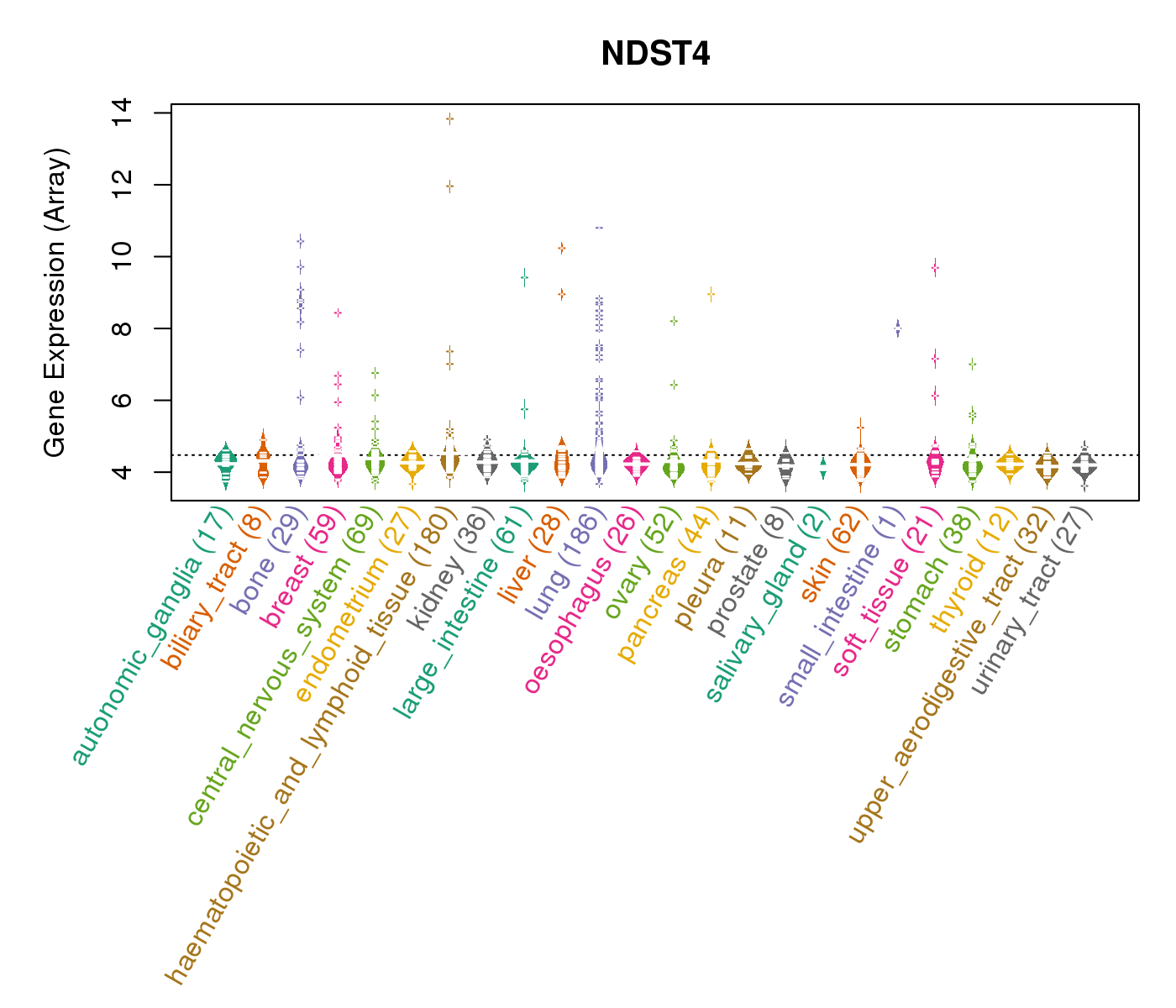 |
| * Normalized gene expression data of RNASeqV2 was extracted from TCGA using R package TCGA-Assembler. The URLs of all public data files on TCGA DCC data server were gathered at Jan-05-2015. Only eight cancer types have enough normal control samples for differential expression analysis. (t test, adjusted p<0.05 (using Benjamini-Hochberg FDR)) |
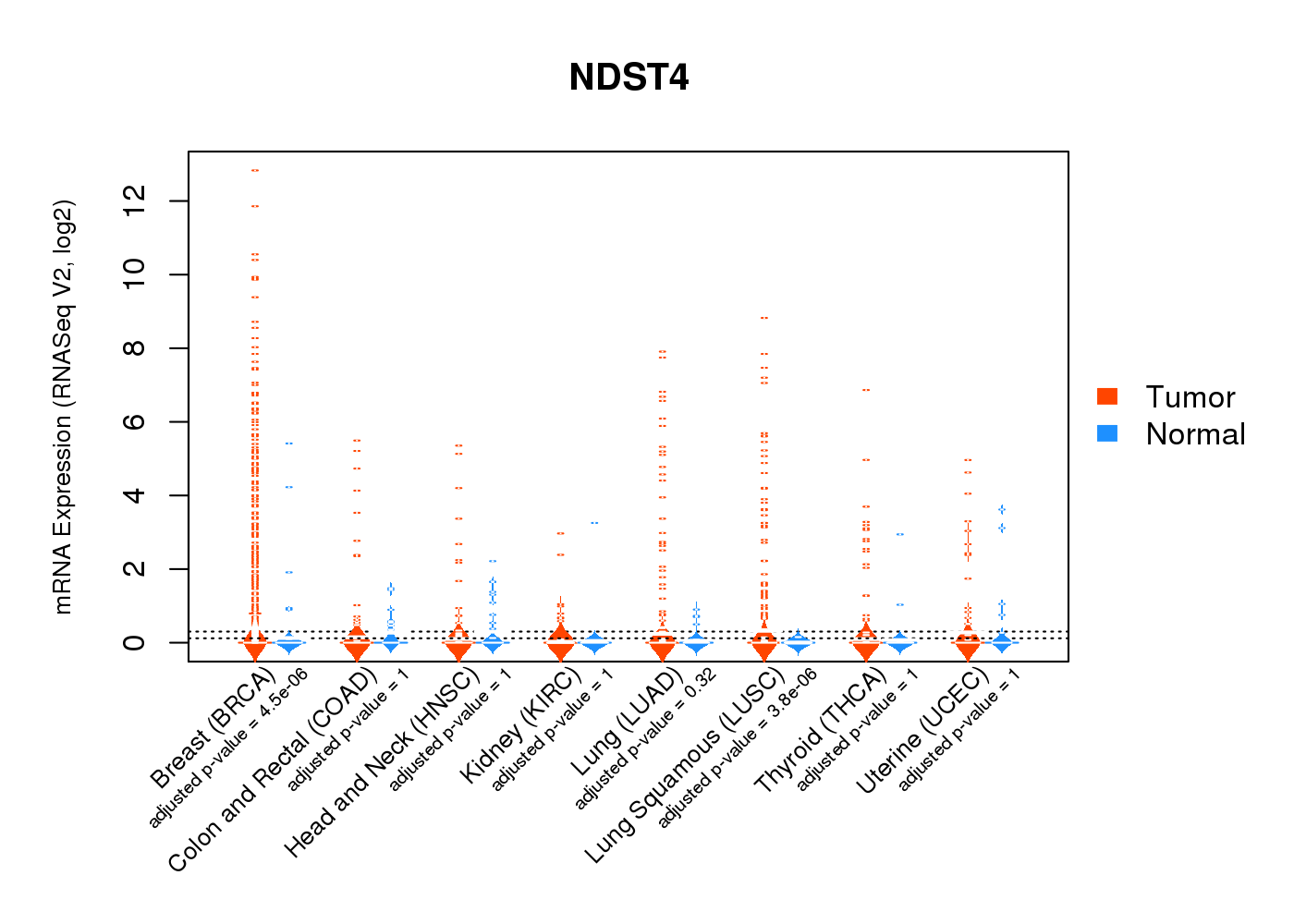 |
| Top |
| * This plots show the correlation between CNV and gene expression. |
: Open all plots for all cancer types
 |
|
 |
|
| Top |
| Gene-Gene Network Information |
| * Co-Expression network figures were drawn using R package igraph. Only the top 20 genes with the highest correlations were shown. Red circle: input gene, orange circle: cell metabolism gene, sky circle: other gene |
: Open all plots for all cancer types
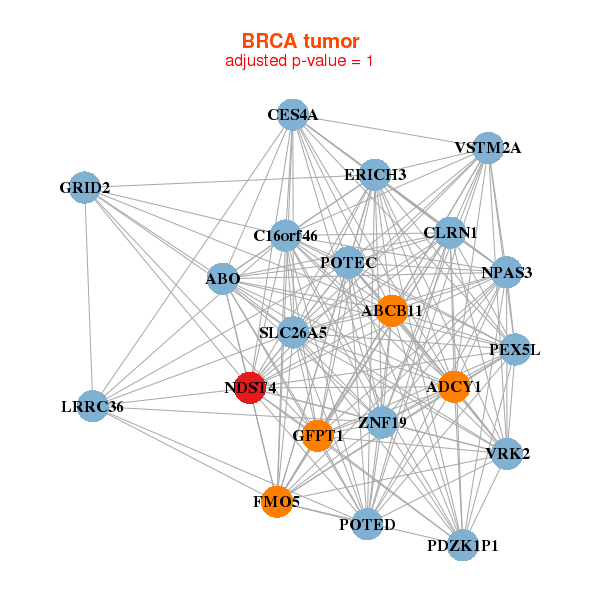 |
|
| ABCB11,ABO,ADCY1,C16orf46,ERICH3,CES4A,CLRN1, FMO5,GFPT1,GRID2,LRRC36,NDST4,NPAS3,PDZK1P1, PEX5L,POTEC,POTED,SLC26A5,VRK2,VSTM2A,ZNF19 | ACTBL2,C4BPA,CBLN4,CLDN1,DEFB131,FOXR2,GRID2, GRIK2,HTR1A,LRRC36,NAA11,NDST3,NDST4,NTS, OR6Y1,PRAMEF11,PRSS48,RAG2,RBMXL3,RGS2,SLC26A2 |
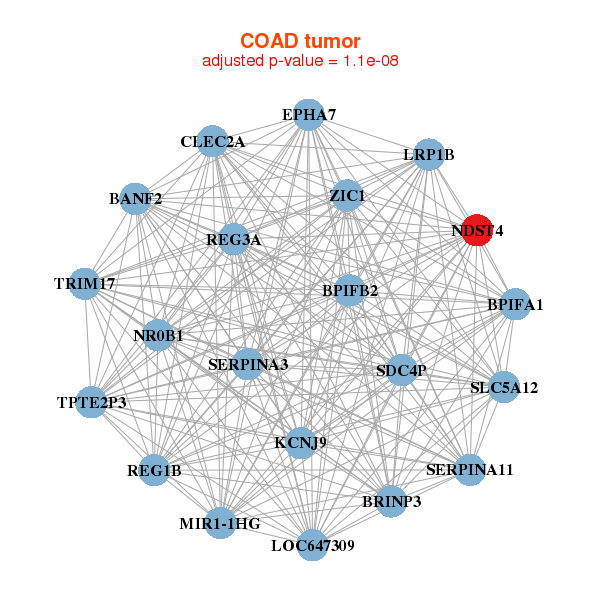 |
|
| BANF2,BPIFB2,MIR1-1HG,CLEC2A,EPHA7,BRINP3,KCNJ9, LOC647309,LRP1B,NDST4,NR0B1,BPIFA1,REG1B,REG3A, SDC4P,SERPINA11,SERPINA3,SLC5A12,TPTE2P3,TRIM17,ZIC1 | ATXN7L3B,LINC00518,CUL4B,EIF3L,GNRHR2,KRT40,FAR2P1, LRRC39,MATR3,METTL14,MUM1L1,NDST4,PAIP2B,PPP2R5C, RBM4B,RPL22,SIAH2,TBCK,TMEM67,ZNF615,ZNF830 |
| * Co-Expression network figures were drawn using R package igraph. Only the top 20 genes with the highest correlations were shown. Red circle: input gene, orange circle: cell metabolism gene, sky circle: other gene |
: Open all plots for all cancer types
| Top |
: Open all interacting genes' information including KEGG pathway for all interacting genes from DAVID
| Top |
| Pharmacological Information for NDST4 |
| There's no related Drug. |
| Top |
| Cross referenced IDs for NDST4 |
| * We obtained these cross-references from Uniprot database. It covers 150 different DBs, 18 categories. http://www.uniprot.org/help/cross_references_section |
: Open all cross reference information
|
Copyright © 2016-Present - The Univsersity of Texas Health Science Center at Houston @ |






